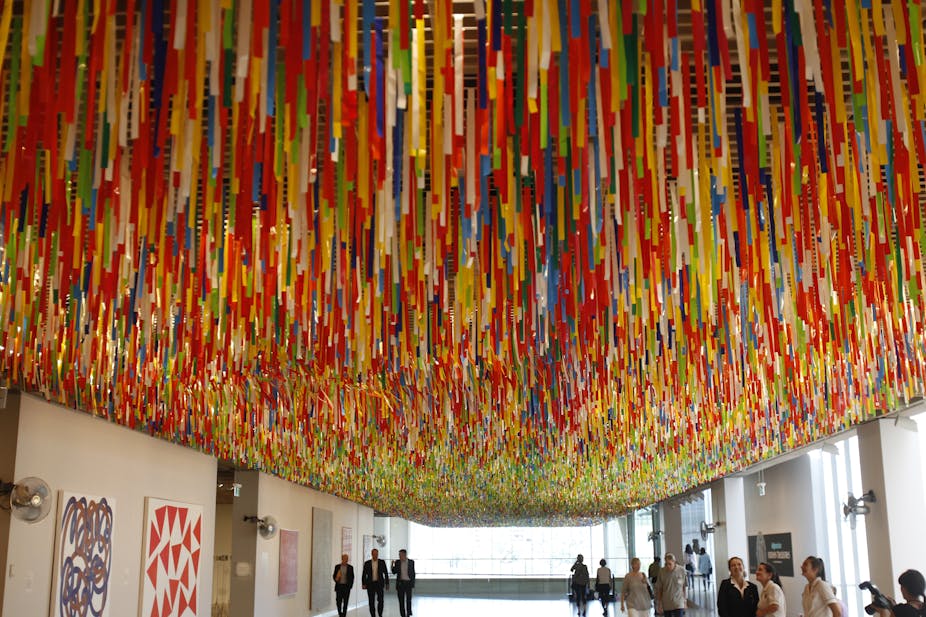Although some doubted the 19th Biennale of Sydney would proceed after the split from founding sponsor Transfield, the country’s biggest contemporary art event opens this week in Sydney. Debate continues about the ethics of arts funding and the social responsibilities of artists, with Guido Belgiorno-Nettis (the brother of Luca Belgiorno-Nettis, the former chair of the Sydney Biennale) this week criticising the artists involved in the boycott of the event.
This year is the 19th Biennale since the event’s inception in 1973; since then works by more than 1,500 artists from more than 100 countries have been exhibited.
This year, it’s been a media spectacle – but large media coverage and biennales tend to go hand in hand, albeit for a variety of reasons. Why?
To answer that, we need to look at the history of biennales in the contemporary art world.
An art biennale – Italian for “every other year” – was first hosted in Venice in 1985. Its aim was ambitious – to draw the aesthetic and sensory world into a solitary, didactic space. This first Venice Biennale served as a model and there are now [more than 150 biennales](http://www.biennialfoundation.org/biennial-map/](http://www.biennialfoundation.org/biennial-map/) internationally.
Although these art events do tend to take place every two years, the contemporary use of the term “biennale” is more conceptual than literal. Rather the term indicates a major, recurrent art exhibition identified with the city or state. Contemporary art historians have further distinguished the term from its initial meaning as one that includes spatial and perspectival features, or a “space-theoretic typology” to acknowledge the discursive features characteristic of contemporary biennales.
The development of the biennale in national terms has prompted a new interdisciplinary science of “bienniology”. The Biennial Foundation was established in 2009 and the first World Biennial Forum took place in 2012. A journal, Seismopolite was established in 2011 and takes as its focus biennales in the developing world.
There’s no biennale without politics
The art director of the Sydney Biennale’s 19th installment, Juliana Engberg, has maintained a travel blog, Engberg on the Road, documenting her research for the Sydney event. In September 2013, Engberg attended the Istanbul Biennale, Mom, Am I Barbarian?, accompanying the curator Fulya Erdemci in the weeks leading up to its unveiling amid a violent crackdown of anti-government protests in Istanbul. Members of the Turkish public were demanding a dismantling of the Biennale.
Showing she is no stranger to political tumult around art, Engberg described the moments leading up to the opening:
Fulya [Erdemci] had already started to formulate her thoughts around Istanbul and its sites of territorial, political, economic and social contest. Her plan – as she described it to me at the time – was to … interrogate the shifting status of ownership and occupation. This was extending out to questions about citizenship, language, shared futures and solutions rather than divided pasts; while of course, acknowledging differences and accepting otherness.
Both of us feel strongly that art has a purposeful language, and a role to play in providing metaphoric dreams and aspirations for a future positive, even if describing the unsettled present and the haunted, dispiriting past. The language of art might include protest, but it is often better nuanced than bluntly didactic or documentary …
Julian Meyrick, writing on The Conversation this week about the response of federal Minister for the Arts George Brandis’ response to the Biennale boycott, issued four directives to arts ministers. One of them resonates here:
[w]hatever happens in politics ends up in the arts. That’s because it’s artists’ job to be socially responsive. So no Fake Shock when art ends up a battleground for the issues of the day.
This socially responsive role for artists is the one envisaged by Engberg in Istanbul. A nation’s political climate ought to be mirrored in an event such as the Sydney Biennale.
Something more than an Art Olympics
The Sydney Biennale is a kind of art “superevent”, akin to what New Yorker’s art critic Peter Schjeldahl contemptuously termed “Festivalism”. These events are often the target of scepticism both for their commercial motivations and the way that might complicate a notion of “authentic” national culture.
As theorised by Indian cultural scholar Ranjit Hoskote, a biennale is not just a set of surfaces but rather:
a discursive environment: a theatre that allows for the staging of arguments, speculations, and investigations concerning the nature of our shared, diversely veined, and demanding contemporary condition.
Biennales do have shortcomings, but to dismiss the events as a whole, he argues “would be to fail to take into account a platform that has undeniably given rise to some of the most engaged debates and thought-provoking artworks of our time”.
That’s why the Sydney Biennale retains its relevance in the Australian cultural canon. It’s also why debate about the political implications of the Biennale and scrutiny of its sponsorship arrangements are essential.
The 19th Biennale of Sydney opens this weekend. Details here.
Are you an academic or researcher working on contemporary art? Contact the Arts + Culture editor.

